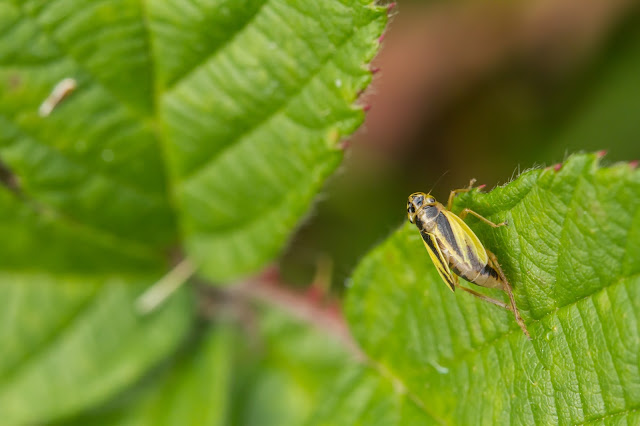Issus coleoptratus is a species of true bug in the infraorder Fulgoromorpha, more commonly known as planthoppers. These insects can be found across the world, and over 12,500 species have been discovered. In the UK, most planthoppers are rather small, and are most well-known to the public by their nymphs, which produce a frothy substance around them commonly known as 'cuckoo spit'. This foam is common on vegetation during the summer, and often I have been using my sweep net in a meadow, when I find a blob of cuckoo spit on my hand. The froghopper nymph produces this substance to deter predators, as they hide amongst the foam until they are an adults.
An example of a particularly colourful British froghopper, Cercopis vulnerata.
Another rather colourful species, Evacanthus interruptus
I am sure that most people who are interested in natural history, will have heard of these insects, or the cuckoo spit that they produce. What they may not know, however, is that these creatures have gears in their legs!
Which leads us back to I. coleoptratus. This species is fairly common and does not stand out as particularly special. It grows up to 7 millimetres long, and is usually a dull shade of brown or olive. It feeds on a substance found in trees called phloem, and it cannot fly. The nymphs of this species were being studied by Gregory Sutton of the University of Cambridge, and in particular he was interested in how they jumped. He noticed that when they pushed themselves off, their hind legs moved within 30 microseconds of each other, every single time. Pretty impressive coordination, but essential for an animal that relies on jumping to escape predators. After all, if the legs were out of time when they pushed off, it could send the insect spiralling off on a slant.
Of course, the real question is not why it needs such fine precision, but how it manages it - there wouldn't be time for the nervous system to control such things. This baffling discovery was followed by some experiments on the insects, which came to an incredible conclusion.
On the base of an insect's leg is a segment called the trochanter. In the froghopper, the trochanters of both hind legs have fine ridges (each tooth is around the fraction of the width of a hair!), and as the bases of the hindlegs touch, the ridges interlock - just like gears. As the legs pushed off, the ridges rolled against each other, keeping both limbs in time with the other.
These gears in I. coleoptratus are only present in the nymphs. Once they become adults, they shed their skin, and the ridges on their trochanters with it. So are the adults doomed to go spinning off in an uncontrolled jump every time they try and leap away from danger? Well, actually they're even better at jumping than the nymphs are! Instead, the adults probably use friction to help synchronize their legs, though this is not yet fully understood and definitely not for certain. But why don't the adults keep the neat gear system that works so well for the nymphs? Well, the thing about adult froghoppers is that they never moult, so if part of their cogs broke, they wouldn't be able to grow it back when they shed their skin, as the nymphs would do. If they lost a single tooth on the cog, then the damage would remain there, and it would always spin off to the side when it tried to escape from a predator, making it much more vulnerable than in a controlled jump. This is probably the reason why the adults don't use the same cog-like structures of the nymphs.
The gears found on I. coleoptratus are not unique, however: all planthoppers have them. In fact, people have known about these structures since the 1950s, but nobody knew what they were for. No further research was done on them, until Gregory Sutton, while studying insect movement, unwittingly stumbled upon the answer.
Now if you see some cuckoo spit in your garden, you will be able to admire the wonder of nature that lives within it: the steampunk insect with gears in its legs. The humble froghopper is truly an incredible invertebrate.
Until next time, keep on the wild side!


No comments:
Post a Comment